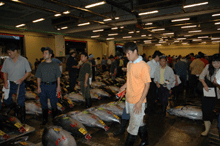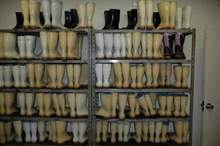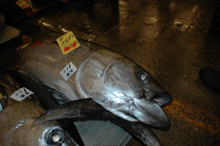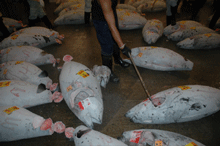Fish Stories
Air Date: Week of August 18, 2006

Fresh tuna auction. (Photo: Kelly Jones)
The largest seafood market in the world, Tokyo’s Tsukiji, awakens early as fish are auctioned off to impatient buyers who inspect the soon-to-be sushi with flashlights and machetes. Reporter Kelly Jones has this audio postcard.
Transcript
CURWOOD: Tourists are no longer welcome at the fresh and frozen tuna auctions at the Tokyo central wholesale market known as Tsukiji. It seems all those camera-toting curiosity seekers were getting in the way of business. Fortunately for us, Kelly Jones and her microphone did get the chance to record and send us this audio postcard.
JONES: More than six and a half million pounds of seafood from the world’s seven oceans arrive here at Tsukiji nightly. One kind in particular, bluefin tuna, darling of sashimi platters and, some say, endangered because of it. I trade in my shoes for a pair of cream colored galoshes and make it just in time for the opening bell of the fresh tuna auction.

(Photo: Kelly Jones)
JONES: Picture an airplane hangar filled row upon row with fat titanium- and black-skinned fish so huge a hefty 10-year old could crawl inside. There are 350, maybe 400 of the submarine-shaped bluefin lying on individual wooden platforms on the cement floor. In just over an hour, all of them will sell.
[AUCTIONEER CHANTING]
JONES: An auctioneer on a footstool bobs and sways like a minister in a Pentecostal church. He moves ecstatically, all hand gestures and nods, his shoulders scrunching in time with his singsong chant.
JONES: All around him, potential buyers don poker faces and wield long-handled hooks. They crouch with flashlights, peer into sliced open bellies and prod cleaned-out cavities for the magic combination of scarlet flesh and abundant fat.
CUSTOMER: How much are these tuna selling for?
MERCHANT Expensive tuna cost 30,000 per kilo. And the average is 2,500.
JONES: That’s 30,000 yen, or about 280 dollars a kilo for a typical whole fish so giant it takes two grown men with hooks a few swings and then one mighty heave to hoist the creature onto a flatbed wheelbarrow.

Fresh tuna. (Photo: Kelly Jones)
JONES: Just a few steps away, men toss empty styrofoam boxes into a story-high heap and guys on tiny diesel trucks zigzag around them as another auction gets underway, this one for frozen tuna.
[STYROFOAM SQUEAKING]
JONES: These fish look ghostly all covered in frost, and when the day’s heat collides with their cold, a billow of fog wafts up from the floor. One picky fellow thwacks away at a fish, its frozen meat flaking off the blunt end where its tail used to be. These are the mebachi tuna. English name: big eye. And there are a lot of big eyes staring out at me, as I turn to find the market for live fish.

Dragging frozen tuna. (Photo: Kelly Jones)
JONES: A few flights up at street level, I see a maze of wooden tables holding square blue plastic baskets that bubble with sea water, keeping the just caught contents alive. In one basket, a half-dozen silver mackerel are floating listless on their sides. I turn around just in time to see a lithe young man wearing a bloody apron pull a wide, flat flounder from a bucket, smack it down on a cutting board and slit it clean down the belly. As he reaches for the next one, I head for the exit, which takes me right past a bucket of still-twitching fish heads gasping their last.
[CARS GOING BY ON THE STREET]
JONES: Out on the street, I happen by chance at NamiYoke, the guardian shrine for Tsukiji. It’s a place where buyers and sellers give thanks for the fish and the livelihood they bring. Tombstones for the fish line the wall, as if saying, rest in peace, little fellas. Sorry we had to cut your heads off. Just seeing this makes me feel better. So does the sight of a man carrying two empty wicker baskets bowing deeply at the shrine before hurrying off to the market. I’m Kelly Jones.
[MUSIC: Anonymous Japanese Flute Music]
Living on Earth wants to hear from you!
Living on Earth
62 Calef Highway, Suite 212
Lee, NH 03861
Telephone: 617-287-4121
E-mail: comments@loe.org
Newsletter [Click here]
Donate to Living on Earth!
Living on Earth is an independent media program and relies entirely on contributions from listeners and institutions supporting public service. Please donate now to preserve an independent environmental voice.
NewsletterLiving on Earth offers a weekly delivery of the show's rundown to your mailbox. Sign up for our newsletter today!
 Sailors For The Sea: Be the change you want to sea.
Sailors For The Sea: Be the change you want to sea.
 The Grantham Foundation for the Protection of the Environment: Committed to protecting and improving the health of the global environment.
The Grantham Foundation for the Protection of the Environment: Committed to protecting and improving the health of the global environment.
 Contribute to Living on Earth and receive, as our gift to you, an archival print of one of Mark Seth Lender's extraordinary wildlife photographs. Follow the link to see Mark's current collection of photographs.
Contribute to Living on Earth and receive, as our gift to you, an archival print of one of Mark Seth Lender's extraordinary wildlife photographs. Follow the link to see Mark's current collection of photographs.
 Buy a signed copy of Mark Seth Lender's book Smeagull the Seagull & support Living on Earth
Buy a signed copy of Mark Seth Lender's book Smeagull the Seagull & support Living on Earth

